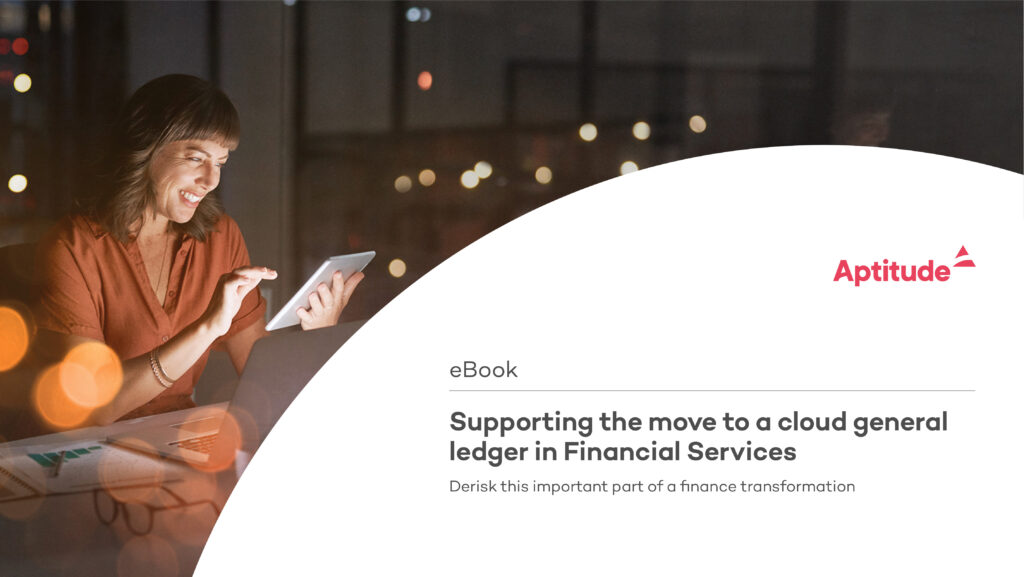One of the most challenging cloud projects for a Financial Services company can be the shift from an on-premise ERP solution – which includes the general ledger (GL) – to a cloud-based ERP solution.
Transitioning this core system – or systems as many organizations end up with multiple GLs due to merger and acquisition activity – from a deeply entrenched, highly customized solution to a SaaS solution can be very beneficial in terms of reducing the overall cost of finance and increasing automation and efficiency.
However, it introduces certain challenges and risks that must be addressed.
Considerations when moving to a cloud general ledger
Aligning to solution standardization
When an organization moves from an on-premise implementation to a SaaS offering, it’s widely accepted that your ability to customize the solution will be at least reduced or simply not permitted. The efficiencies gained from the cloud depend on some level of accepted standardization. Cloud GL solutions are no different.
Migrating from an on-premise solution that has been customized for years, to a mostly standardized offering, has risks. Since nearly every on-premise general ledger application environment today is likely customized to some degree, organizations need to be aware that they will likely have to abandon some of the custom business processes they currently utilize – or find another solution to execute those processes.
In other words, if the unique business processes supported by your customizations can’t be reduced to configuration settings within a cloud software solution, you should expect that you likely have to give them up.
Likewise, Cloud GL solutions will not fix bad data or inefficient, inconsistent processes. In fact, they will only amplify existing issues because the ability to manipulate the system to make it work is significantly reduced.
“Banks like being able to drive standardization. They see that as a positive thing. Cloud models don’t give you much flexibility to create bespoke modules and applications…but it’s about taking advantage of the leading, best in class processes that are encapsulated in the vendor technologies.”
-Brian Anderson, Principal, KPMG (Podcast)
Data migration
There are a number of data aspects to consider when migrating to a cloud general ledger solution. For example, a Financial Services company likely has many legacy IT systems that are not designed to work in a cloud environment, making data compatibility a challenge. This may require companies to manually recreate data which introduces cost and risk. A cloud GL may also have specifications around certain data formats or the application of a data model or accounting rule.
Additionally, it may not be possible or cost-effective to store detailed transaction data in a cloud general ledger. Many of today’s GLs are overburdened with too much data. Making the move to a cloud GL can offer the chance to rethink your data strategy and commit to using the GL as it was intended, supporting by an integrated accounting hub and subledger to maintain detailed transaction data.
Surrounding services
Part of the drive to move to the cloud is the cost reduction potential through the ability to decrease infrastructure costs. However, an organization can only enjoy the cost savings of the cloud if its IT infrastructure is designed for the cloud. “If an organization ‘lifts and shifts’ legacy applications to cloud environments or purchases oversized service packages, then the cost of the cloud may exceed the cost of hosting the same infrastructure on-premises.” (source)
Moving to a cloud solution may also require additional investments in vendor infrastructure for test and development instances. When considering the solution price and discount, make sure you understand the surrounding solutions that will be required to get the final capabilities you need.
“The biggest thing that is going to go away [with the cloud GL migration] are all the supporting spreadsheets that live on LAN drives and people’s desktops and who knows where.”
-Nancy Moore, Senior Director of Accounting, OneAmerica (Webinar: Adopting a cloud-first ERP and GL Strategy)
Getting a cloud general ledger migration right
While there are plenty of risks to mitigate when implementing a cloud ERP solution, there are companies who are getting it right and de-risking their implementations with a subledger solution. To learn more about these organizations and the approach they are taking, please download our eBook: Supporting the move to a cloud general ledger in Financial Services



